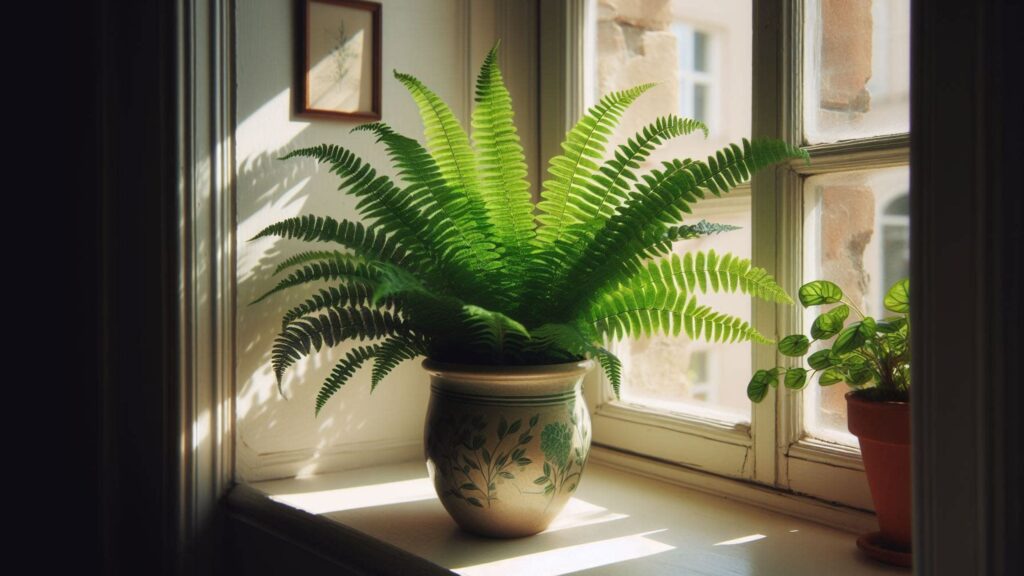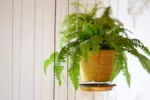The Boston Fern, scientifically known as Nephrolepis exaltata, is a lush and classic houseplant that’s popular for its ease of care and visual appeal. The Boston Fern (Nephrolepis exaltata) is a popular houseplant known for its lush, cascading fronds. It’s a popular choice for indoor spaces due to its relatively easy care requirements and air-purifying properties.

Types of Boston Fern Plant
Benefits of Boston Fern Plant
Here are some of the key benefits:
Air Purification: Boston Ferns are known to improve indoor air quality by absorbing common pollutants. They are particularly effective against formaldehyde, which can be emitted from fuel stoves, space heaters, and pressed wood products
Increased Humidity: Boston Ferns thrive in humid environments. As they release moisture into the air through transpiration (the process by which plants release water vapor), they can help combat dry air, especially beneficial in winter or dry climates. This can alleviate problems like dry skin, itchy throats, and coughs.
Stress Reduction and Relaxation: Studies have shown that having plants indoors can have positive effects on mental health. The lush green foliage of a Boston Fern can create a calming and tranquil atmosphere, potentially reducing stress and anxiety.
Aesthetic Beauty: Undoubtedly, Boston Ferns add a touch of elegance and sophistication to any space. Their cascading fronds bring a vibrant touch of nature indoors, making them a popular choice for creating a refreshing and inviting atmosphere.
Low Maintenance: While they do require consistent moisture, Boston Ferns are generally considered easy to care for. With proper watering, indirect light, and occasional misting, they can thrive indoors for extended periods.
Disadvantages of Boston Fern Plant
They do have a few drawbacks, too, so keep that in mind:
Humidity Requirements: Their love for humidity can be a challenge in drier climates or during winter months. Maintaining consistent moisture levels can involve frequent misting, using a humidifier, or employing pebble trays.
Fussiness with Water: Finding the right watering balance can be tricky. Overwatering can lead to root rot, while underwatering causes dry, crispy fronds. They require consistent moisture, but not soggy soil, so finding that sweet spot can take some practice.
Susceptibility to Pests and Diseases: Boston Ferns can be attractive to common houseplant pests like mealybugs, whiteflies, and fungus gnats. They’re also prone to fungal diseases like root rot if not watered properly. Regular monitoring and appropriate treatment are necessary to keep them healthy.
Moderate Growth Rate: Don’t expect a super fast-growing plant. Boston Ferns grow steadily but not rapidly. This might not be the best choice if you’re looking for a houseplant that fills out space quickly.
Potential Toxicity: While not fatal, Boston Ferns are mildly toxic to pets and humans if ingested. The fronds contain toxins that can cause stomach upset, vomiting, and diarrhea. Keep them out of reach of curious children and pets.
Boston Fern Plant Care
Here’s a breakdown of their key needs to keep your fern thriving:
Light: Bright, indirect sunlight is ideal. Steer clear of the intense sun, since it might burn the foliage. East-facing windows are perfect for providing that gentle morning light.
Water: Consistent moisture is key, but don’t let the soil get soggy. When the top inch of soil appears dry to the touch, deeply water the area. You can also stick your finger in the soil – if it feels moist, hold off on watering.
Humidity: Boston Ferns love high humidity. Mist the leaves regularly with room temperature water, especially in dry climates or winter. Placing the pot on a pebble tray filled with water can also help increase humidity around the plant.
Fertilizer: Feed monthly during the growing season (spring and summer) with a balanced liquid fertilizer diluted to half strength. Withhold fertilizer during the winter months when the plant is less actively growing.
Temperature: Maintain warm temperatures between 65-80 degrees Fahrenheit. Keep them away from heat vents and chilly breezes.
Repotting: Repot every 1-2 years into a slightly larger pot with fresh potting mix when the roots outgrow the current pot.
Propagation of Boston Fern Plant
Here are the common methods for propagation:
Division: This is the most straightforward method. Simply take the plant out of its pot and gently separate the root ball into smaller sections, each with some roots and fronds. You can use a sharp knife or shears to cut through the roots if they are densely packed. After dividing, plant each section in its own pot with fresh potting mix and water well.
Runners: Boston Ferns produce runners with small plantlets at their ends. Once these plantlets have formed roots, you can cut the runner and plant the plantlet in a separate pot. Keep the soil moist and maintain high humidity around the new plant to encourage growth.
Spores: This method is less common and more complex. Mature ferns produce spores on the undersides of their fronds. Collect the spores and sow them on a moist, sterile potting mix. To keep the container damp, cover it with plastic. It can take a few weeks to several months for spores to germinate and grow into new plants.
Repotting of Boston Fern Plant
Water the Fern: A few days before repotting, thoroughly water the fern. It is simpler to work with moist soil.
Prepare the New Pot: Add a layer of fresh potting mix to the bottom of the new pot for drainage.
Remove the Fern: Gently squeeze the sides of the current pot to loosen the root ball. Then, carefully tip the pot and slide the fern out. Check the Roots: Briefly inspect the roots. Prune away any dead or damaged roots with sterilized shears.
Position in New Pot: Place the fern in the new pot, ensuring it sits at the same depth as before.
Fill the Pot: Fill the pot with fresh potting mix, gently tamping it down to remove air pockets.
Water Thoroughly: Water the fern generously until water runs out the drainage holes.
Boston Fern Plant Disease
Here are some common issues associated with Boston Ferns and how to address them:
Graying Greens and Yellowing Fronds:Symptom: Gray or lighter green fronds indicate insufficient water. Yellowing and browning may signal pest infestations or diseases.
Solution: Ensure consistent moisture in the soil. If discoloration persists, check for pests or diseases.
Fronds Drooping:Symptom: Long, thin, drooping fronds due to low light levels. Dark green fronds suggest insufficient light.
Solution: Move the fern to a brighter spot with indirect sunlight. Avoid direct southern exposure. Consider rotating the plant for optimal growth.
Runner Burn and Leaf Tips Browning:Cause: Brown fronds due to sunburn from prolonged direct sunlight.
Solution: Adjust the fern’s position to avoid intense sunlight. If not sunburn, excessive salt accumulation might be the issue. Adjust fertilization.
Common Pests: Mealybugs, scales, fungus gnats, and caterpillars are among the pests that Boston ferns are susceptible to.
Symptoms: Wilted, yellow leaves due to nutrient loss from pest feeding.
Treatment: Use insecticides, Neem oil, or rubbing alcohol solutions to get rid of pests
Boston Fern Plant Vastu
Vastu Shastra, which is an ancient Indian system of architecture and design, plants plays a significant role in bringing positive energy into a space. The Boston Fern, known for its lush green foliage, is considered auspicious when placed according to Vastu guidelines.
According to Vastu experts, the Boston Fern should be planted in the northwest side of the office or home to attract fortune, prosperity, and luck1. This direction is believed to be associated with wealth and career success, and placing a Boston Fern there can enhance these aspects of one’s life.
Boston Fern Plant for Pets
Here’s a quick rundown:
Non-Toxic: According to the ASPCA, Boston Ferns are non-toxic [ASPCA Boston fern]. This means ingesting a small amount won’t cause harm to your furry friend.
Digestive Upset: However, even non-toxic plants can cause stomach upset if your pet eats a lot of them. The fern’s fronds might irritate their digestive system, leading to vomiting or diarrhea.
Safe Alternatives: If you’re concerned about your pet nibbling on the fern, consider providing them with cat grass or other pet-safe plants like spider plants or ponytail palms.
Monitor Your Pet: Regardless, it’s always best to keep an eye on your pet around any houseplant.
How to Buy Boston Fern Plant
Buying a Boston Fern is quite straightforward, and you have several options to choose from:
Local Garden Shops: Boston Ferns are commonly available at local garden centers. They can usually order one for you if they don’t have one in stock.
Online Nurseries: You can find a variety of Boston Ferns available for purchase online. Websites like PlantsGuru.com offer a range of ferns, and you can often find good deals and a wider selection than in physical stores
Boston Fern Plant Names in Other Languages
Here are some of the names it’s known by in other languages:
- Spanish: Helecho de Boston
- French: Fougère de Boston
- German: Bostonfarn
- Italian: Felce di Boston
- Dutch: Bostonvaren
- Russian: Бостонский папоротник
- Chinese (Simplified): 波士顿蕨
- Japanese: ボストンファーン
- Korean: 보스턴 고사리
- Telugu: బొస్టన్ ఫెర్న్ చెట్టు (Boston Fern Chettu)
- Hindi: बॉस्टन फर्न पौधा (Boston Fern Paudha)
- Kannada: ಬಾಸ್ಟನ್ ಫರ್ನ್ ಸಸ್ಯ (Boston Fern Sasya)
- Tamil: பாஸ்டன் ஃபெர்ன் தாவரம் (Boston Fern Thaavaram)
Conclusion
Boston Ferns thrive in indirect sunlight, well-draining moist soil, and moderate temperatures. They don’t require a lot of attention, making them perfect for beginner plant owners.
FAQs of Boston Fern Plant
1. What are the different types of Boston Ferns?
Ans: The most common type is Nephrolepis exaltata. Others include Ruffle fern with ruffled edges, Crispy wave fern with wavy fronds, and Tiger fern with striped markings.
2. What are the benefits of having a Boston Fern?
Ans: They clean the air, add moisture, are easy to care for, and look beautiful.
3. Are there any downsides to Boston Ferns?
Ans: They can get brown fronds if underwatered/overwatered, lack humidity, or get too much sun. They might attract pests like mealybugs.
4. How do I care for my Boston Fern?
Ans: Give it indirect sunlight, water it regularly (keeping the soil moist but not soggy), and mist it or use a humidifier for high humidity. Fertilize monthly during spring and summer.
5. Can I propagate a Boston Fern?
Ans: Yes! You can divide the plant or grow new ones from spores (though spores are trickier).
6. When should I repot my Boston Fern?
Ans: Every 1-2 years, or when the roots overcrowd the pot. Pick a pot with enough drainage that is one size bigger.
7. What diseases can affect Boston Ferns?
Ans: Fungal diseases like root rot and bacterial diseases can cause problems.
8. Are Boston Ferns safe for pets?
Ans: Yes, luckily, they are non-toxic to both pets and children.
9. Does Vastu recommend Boston Ferns?
Ans: Yes, they are considered lucky and bring positive energy. Place them in the east or north direction for best Vastu effects.



I just wanted to construct a small message to be able to say thanks to you for these precious points you are showing here. My extensive internet lookup has finally been rewarded with sensible content to talk about with my company. I would suppose that we readers are extremely endowed to dwell in a remarkable site with many brilliant people with helpful opinions. I feel very much happy to have encountered your web site and look forward to really more pleasurable times reading here. Thank you once again for all the details.
Awesome page with genuinely good material for readers wanting to gain some useful insights on that topic! But if you want to learn more, check out UY8 about E-Book Marketing. Keep up the great work!
I like forgathering useful info, this post has got me even more info! .